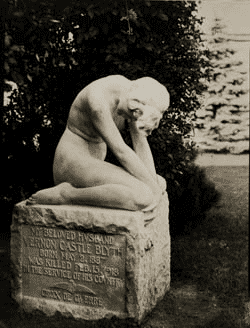The Woodlawn Cemetery Donates Archives to Columbia’s Avery Architectural & Fine Arts Library
NEW YORK, June 15, 2006 - Columbia University’s Avery Architectural & Fine Arts Library will acquire a vast archive of architectural designs, maps, photographs, mausoleum blueprints, correspondence, maintenance records, and other historical documents donated by the Woodlawn Cemetery and spanning 140 years of the cemetery’s operations.

The collection includes documentation on mausoleums and memorials designed by John Russell Pope, McKim, Mead, & White, Tiffany Studios, and other accomplished artists and architects. It also features documents related to memorials for many of the prominent figures in jazz, theater, literature, business, and politics who are buried on the cemetery’s 400 acres, which include Duke Ellington, Miles Davis, Coleman Hawkins, W. C. Handy, Milt Jackson, King Oliver, George M. Cohan, Herman Melville, Joseph Pullitzer, Robert Moses, Fiorello LaGuardia, William Whitney, Elizabeth Cady Stanton, the Woolworths, the Belmonts, and the Juilliards.
“The Woodlawn Cemetery Archive documents the development of one of the greatest of all American cemeteries” said Gerald Beasley, Director of the Avery Library. “It is also a fundamental part of New York’s collective memory, and as such complements one of Avery’s established collection strengths. This gift adds an invaluable resource for the national and international communities of architects, planners, historians and preservationists that our Drawings and Archives collections are primarily designed to serve.”
James Neal, University Librarian at Columbia, noted “the University’s deep gratitude to the Woodlawn Cemetery leadership for their commitment to preserve the records of this remarkable institution and for their vision to make the archive available for teaching and scholarship across many disciplines.”
The Board of Trustees of The Woodlawn Cemetery donated the collection to Columbia to help researchers and students access a valuable chronicle of New York City and United States history. The collection includes a database of burial plots, owners, maintenance schedules and other relevant information, as well as cemetery maintenance records, advertising materials, maps and ledger books collected over the years.
“It wasn’t until we began working with the Avery staff that we became aware of what we had and how excited the academic community would be to have access to these materials,” said Jonathan Butler, Chairman of the Board of Trustees of The Woodlawn Cemetery. “By donating a major portion of our archives to Columbia, we have found a way to preserve Woodlawn’s valuable records for generations to come.”
Lot owners at Woodlawn have always been required to provide designs for memorials in advance, so the cemetery can assess their appropriateness and maintenance feasibility. These designs, records, and other materials were kept in the cemetery’s downtown office until it was closed in 1982; for over twenty years, the records were kept in boxes and file cabinets located in various storage areas on the cemetery grounds.
The Woodlawn Cemetery will begin to transfer the archive to the Avery Library immediately and the formal transfer of title will take place on June 15. Because of the volume of documents, it will take approximately five years for the collection to be completely processed and cataloged.
“We plan to transfer the records gradually as and when we are ready to provide access to them,” said Beasley. “We will begin by working with the files associated with private mausoleums and major memorials and eventually the thousands of letters, photographs and plans will be organized to provide access to this extraordinary collection.”
The Woodlawn Cemetery will retain all records associated with burial and lot ownership and those associated with the ongoing operation of the cemetery. Researchers who wish to photograph or copy drawings or correspondence related to mausoleum interiors, stained glass windows, and sculpture for the purpose of publication will be required to obtain permission of the cemetery.
“Woodlawn has over 100,000 monuments and 1300 private mausoleums. As Woodlawn is still a very active cemetery, we are required by state law to maintain and preserve certain records,” said Butler. “In addition, we feel it is important to protect the privacy of our lot owners while honoring those in our care.”
More images from the Woodlawn Cemetery Collection are available at:
http://www.columbia.edu//cu/lweb/news/libraries/2006/2006-06-15.woodlawn_gallery.html
Columbia University Libraries is one of the top ten academic library systems in the nation, with 9.2 million volumes, over 65,650 serials, as well as extensive collections of electronic resources, manuscripts, rare books, microforms, and other nonprint formats. The collections and services are organized into 25 libraries, supporting specific academic or professional disciplines. Columbia Libraries employs more than 400 professional and support staff to assist faculty, students, and researchers in their academic endeavors. The Libraries’ website at http://www.columbia.edu/cu/lweb/ is a gateway to its print and electronic collections and to its services.
The Avery Architectural and Fine Arts Library is one of the most outstanding and comprehensive collections relating to architecture and the fine arts in the world. Avery collects a full range of primary and secondary sources for the advanced study of architecture, historic preservation, art history, decorative arts, city planning, real estate, and archeology. The Library contains more than 400,000 volumes, including 35,000 rare books, and receives approximately 1,000 periodicals. Avery’s Drawings and Archives collection includes one million architectural drawings and records. The Library is home to the Avery Index to Architectural Periodicals, an operating program of the Getty Research Institute, which is the only comprehensive American guide to the current literature of architecture and design.
The Woodlawn Cemetery was founded in 1863 and includes 400 acres of rolling lawns, spectacular trees and impressive memorials designed by many of the nation’s most accomplished artists and architects. The Woodlawn Cemetery continues to provide quality service to the diverse New York community, assisting families and individuals at their time of need and helping them to plan for the future.